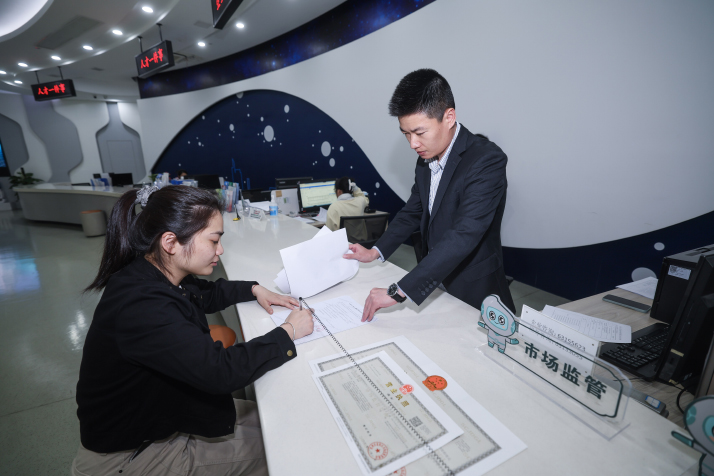| Voice |
| Powering synergy for a shared future | |
|
|
 A business service center in Fuyang Economic Development Zone in Hangzhou, Zhejiang Province, on April 17 (XINHUA)
As Chinese President Xi Jinping undertook a tour of Southeast Asia, visiting Malaysia, Viet Nam and Cambodia from April 14 to 18, the spotlight fell on the deepening China-Association of Southeast Asian Nations (ASEAN) partnership. At the heart of this partnership lies the Zhejiang Model—a dynamic framework of socioeconomic development, technological innovation and inclusive governance pioneered in the eastern Chinese province of Zhejiang. Shaped by Xi during his tenure as secretary of the Zhejiang Provincial Committee of the Communist Party of China from 2002 to 2007, this model offers a blueprint for China-ASEAN synergy. As Malaysia, the 2025 ASEAN chair under the theme Inclusivity and Sustainability, steers ASEAN toward greater regional integration, the Zhejiang Model illuminates a path to shared prosperity, digital advancement and equitable global governance. A valuable reference for development From 2002 to 2007, Xi championed market-oriented reforms, private entrepreneurship and digital innovation in Zhejiang, transforming the province into China's economic powerhouse with a 2024 GDP of $1.24 trillion. His vision of a "Digital Zhejiang" catalyzed the province's leadership in e-commerce, AI and smart cities, while policies fostering integrated development narrowed the income gap between urban and rural residents to 1.83 last year. Designated a national demonstration zone for common prosperity in 2021, Zhejiang embodies Xi's philosophy of inclusive growth, offering lessons for ASEAN's diverse economies. Zhejiang's vibrant private economy, with 11 million business entities, mirrors China's role as ASEAN's top trading partner, accounting for 17 percent of China's exports. The province's trade hubs, such as the Yiwu-Ningbo-Zhoushan corridor, strengthen connectivity offered by the Belt and Road Initiative (BRI), aligning with ASEAN's Master Plan on Connectivity 2025. (The BRI is a China-proposed initiative to boost connectivity along and beyond the ancient Silk Road routes—Ed.) In Malaysia, BRI projects like the East Coast Rail Link and Malaysia-China Kuantan Industrial Park exemplify this synergy, boosting logistics and manufacturing. Zhejiang's expertise in electronics, textiles and hi-tech industries complements Malaysia's strengths in palm oil and semiconductors, creating a robust trade ecosystem. The robust digital economy is a cornerstone of the Zhejiang Model. Xi's early push for a "Digital Zhejiang" fostered innovations like Hangzhou's City Brain, which optimizes traffic and public services through AI and big data. Currently, Zhejiang leads in 5G, e-commerce and smart manufacturing, offering a model for ASEAN's digital ambitions. Malaysia's Madani Economy framework, emphasizing hi-tech development, aligns closely with Zhejiang's expertise, particularly in 5G infrastructure and smart city projects. Zhejiang University, a global leader in AI and renewable energy, drives technology transfers through initiatives like the Zhejiang Auction, fostering university-industry partnerships. Its newly announced partnership with the Malaysia Digital Economy Corp. (MDEC) in digital transformation, AI and smart cities will facilitate joint research and development, talent exchange and the development of smart city solutions tailored to Malaysia's urban centers such as Kuala Lumpur. By integrating Zhejiang's City Brain expertise with Malaysia's digital ambitions, this collaboration can create scalable models for ASEAN, enhancing urban resilience and economic efficiency. The Zhejiang Model's focus on common prosperity, reducing regional and urban-rural disparities, aligns with ASEAN's inclusive growth agenda. Zhejiang's digital financial inclusion initiatives, championed by Xi, have boosted rural entrepreneurship and equal income distribution, offering a replicable strategy for Malaysia's efforts to bridge urban-rural gaps. Malaysia can leverage Zhejiang's experience to mediate discussions on inclusive development, ensuring that economic gains benefit marginalized communities. This vision of shared prosperity, rooted in Xi's Zhejiang legacy, strengthens China's role as a reliable partner for the Global South of developing and less developed countries. Zhejiang's efficient, service-oriented governance, shaped by Xi's reforms, offers insights for Malaysia's ASEAN chairmanship. Initiatives like the "finance brain" and digital RMB (Chinese yuan) pilots demonstrate streamlined administration, which Malaysia can emulate to enhance ASEAN's regional coordination. Cultural and educational exchanges, a hallmark of Zhejiang's soft power, strengthen China-ASEAN relations. Nearly 6 million mutual visits between China and Malaysia in 2024, facilitated by mutual visa exemptions, highlight the importance of people-to-people ties. Zhejiang University's international programs, including partnerships with ASEAN institutions, foster educational exchanges that underpin the Zhejiang Model's global outreach. While the Zhejiang Model offers immense potential, its urban-centric focus and reliance on coastal advantages require adaptation to ASEAN's diverse economies. Malaysia must tailor Zhejiang's digital and governance innovations to its multicultural context, ensuring rural inclusion.  Workers assemble intelligent logistics robots at a technology company in Jiaxing, Zhejiang Province, on May 15, 2024 (XINHUA)
Push for trilateral cooperation Malaysia will host a landmark China-ASEAN-Gulf Cooperation Council (GCC) Cooperation Summit in May. The event will offer a unique opportunity to integrate Zhejiang's manufacturing prowess with GCC's energy resources and ASEAN's industrial base. By fostering a China-ASEAN-GCC trade nexus, Zhejiang's successful practices can drive economic diversification, helping ASEAN nations cushion the impact of global trade disruptions mainly caused by the Trump administration's "reciprocal tariffs" on trading partners. This alignment underscores China's commitment to win-win cooperation, positioning Zhejiang as a catalyst for regional prosperity. The summit provide a platform to extend Zhejiang's inclusive finance models, supporting small and medium-sized enterprises (SMEs) and green projects across ASEAN and GCC nations. Zhejiang University's research on global governance, now enhanced through its MDEC collaboration, can inform summit outcomes, advocating for a UN-centered international system that prioritizes sovereignty and equity. This alignment enhances China's leadership in shaping an inclusive global order, with Malaysia as a key bridge between China, ASEAN and the GCC. The China-ASEAN-GCC summit offers a historic opportunity to extend Zhejiang's lessons, fostering a tripartite partnership that drives trade, technology and global governance reform. As Malaysia bridges China, ASEAN and the GCC, the Zhejiang Model illuminates a path to a high-level community with a shared future, advancing the Global South toward its aspirations for prosperity and equity. BR Wang Zhengxu is distinguished professor at the School of Public Affairs, Zhejiang University; John Pang is a senior fellow of the Belt and Road Initiative Caucus for Asia Pacific Copyedited by G.P. Wilson Comments to ffli@cicgamericas.com |
|
||||||||||||||||||||||||||||
|